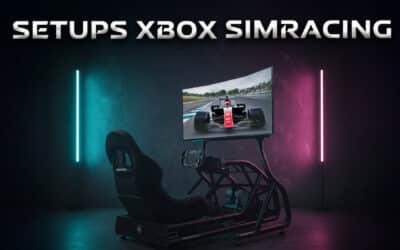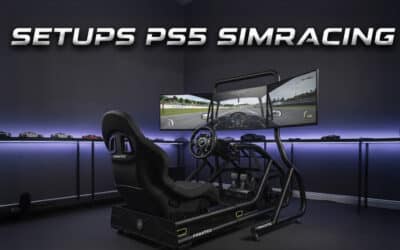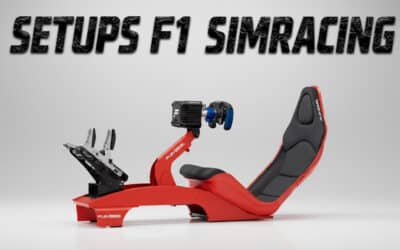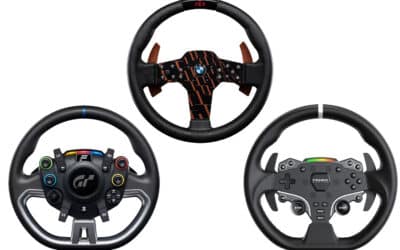Optimizing a sim-racing setup has become not only important, but increasingly widespread. These days, the simplest sim-racing rig incorporates a curved screen, a cockpit and good-quality peripherals for maximum feel.
For drivers wishing to push the immersion envelope even further, D-Boxes and other dynamic simulatorsoffer a higher level of realism by adding body motion effects to the experience. Needless to say, such rigs are prohibitively expensive, costing well over €10,000 for the chassis alone, without the sim-racing equipment that goes with it.
As you know, setting up a sim-racing setup is an expensive business. Of course, budget-friendly options do exist, but the level of realism goes hand in hand with the price. Basically, the less you spend on the setup, the less you’ll feel like you’re in the cockpit of a racing car.
For a decent setup, from Fanatec or Simagic for example, you’re looking at around €1,500 – €2,000, and this includes the Direct Drive base, steering wheel and pedals, and incidentally a shifter or handbrake if you’re into rally racing. Expect to pay between €600 and €1,000 for a quality cockpit, although in reality you can get one for less, but it will be more limited in terms of upgrades. Add to this the machine on which you’ll be running your sim-racing titles (mid-range gaming PC) and a screen, preferably curved, and you’ll end up with a bill of around €3,500 or even €4,000. That’s expensive, yes, but it’s the price you pay for a good setup and racing sensations.
However, there’s one element we haven’t yet covered in our setup, and that’s reality augmentation. For this, you have two options: opt for a
The best eye trackers
#1 Tobii Eye Tracker 5
Let’s start with the Tobii Eye Tracker 5 at the top of the list. It’s a head and eye tracker with a camera and IR sensors, making it the most versatile solution of the lot.
The Tobii Eye Tracker 5 comes in the form of a box about thirty centimetres long, with a minimalist design that I find successful. It comes in a single color, quite dark I must say, which allows it to practically blend into the background.
For installation, you’ll need a flat or curved screen (brackets supplied with Tobii Eye Tracker 5), a distance between 45 and 90 cm from you, and you’re done. However, this tracking device is limited to screens up to 30″, with a 21:9 aspect ratio. But you can use a multi-monitor setup without the slightest hitch.
Performance-wise, it’s frighteningly efficient. Once calibrated via the brand’s software, you’ll have real-time tracking of your head and eyes, without any lag, hesitation or tracking error, and this is made possible by the combination of camera and IR sensors that equip the Tobii Eye Tracker 5.
This device installs below your screen, unlike those that sit on top. In terms of compatibility, the Tobii Eye Tracker 5 works on over 170 titles in all categories. What’s more, the software supplied with it enables native support for games installed on your PC, and the tracker is also Windows Hello compatible, which is literally an extra string to its bow.
Now for the price. The Tobii Eye Tracker 5 retails for €279, making it the most expensive option, but also the most complete as far as I’m concerned.
#2 Beam Eye Tracker
The Beam Eye Tracker is the budget-friendly option of the lot, with a selling price of just $30. However, it’s not an eye tracker per se, but rather an application that can harness webcam data to determine where your head is pointing. Sounds weird, but it works in absolute terms.
For the Beam Eye Tracker, you have 3 options for using this solution: acquire an Eye Tracker-compatible webcam, use the one on your laptop or use your smartphone. As I said earlier, this is the cheapest solution, because it’s really just an application to use. There’s no hardware involved.
Let’s move on to performance. According to my tests, it’s okay, but nothing more. Given that this is an application that has to retrieve data from other equipment (webcam or iPhone), you’ll experience a slight lag between the change in your head position and the fact that the camera is moving on your screen. What’s more, tracking can sometimes be imprecise, for a variety of reasons. The most notable is the light source: if the room you’re in isn’t bright enough, or on the contrary, is too bright, the Beam Eye Tracker will have trouble following your head movements, which can cause lags, hesitation in tracking (non-fluid movement) and sometimes even breaks in tracking. For this reason, the Beam Eye Tracker should be used in the best possible conditions when racing. But it remains a viable option for those with a very limited budget and few resources.
#3 TrackIR
We now move on to the third option, the TrackIR. It’s a head-movement tracker, just like the other two, with a closer resemblance to the Tobii than to the Beam Eye Tracker in the sense that, on the TrackIR, you have IR sensors to detect the movement of your head in its “field of vision”, so to speak.
Like the Tobii, the TrackIR is a fully-fledged device, this time positioned above your screen. The sensor can detect 6 distinct movements of your head, and unlike the Tobii, it can also work with large monitors. However, the latter, as we’ve already seen, supports multi-screen setups. So, what you lose in diagonal with Tobii, you get back with other screens. It’s more expensive in the end, at least in some cases.
Back to the TrackIR. The device is rather large, and not at all discreet. The casing is made of plastic, with a large surface on the front that houses the various IR sensors. Unlike the Tobii’s design, you’ll quickly notice the TrackIR on your screen. What’s more, the brand offers an accessory that fits over your helmet to refine tracking. Personally, I’m not a fan, as it adds not only wiring to your rig, but also weight to your helmet.
When it comes to tracking head movements, the TrackIR is precise and responsive, but given the device’s small size, this has an impact on its “field of vision”. It’s more than possible to lose track of your head if you turn it too far in one direction.
Let’s finish with the price. The TrackIR costs $150, and the helmet accessory is $35. You can buy the whole bundle for $170.
Which one to choose?
As far as I’m concerned, the choice is made along 2 axes:
- The price. If you’re on a tight budget, there’s the inexpensive Beam Eye Tracker option, but it’s still the least powerful of the lot in terms of tracking your head movements.
- Performance. If you’re looking for the best head-movement tracking device, you can’t do better than Tobii. Eye Tracker 5. Still an expensive option, yes, but in terms of performance, motion tracking accuracy, responsiveness and also design, the competition is far behind Tobii’s solution. It’s a safe choice as far as I’m concerned.







0 Comments